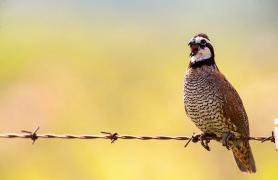Body
- Sproing! Eastern cottontails can leap 15 feet in a single bound. If a cottontail were the size of a third grader, it could hop an astounding 55 feet, which would shatter the world record long jump by more than 25 feet.
- Wake up, sleepy head! Meadow jumping mice spend more than half their lives sleeping. The drowsy rodents crawl into their burrows in October, curl into a ball, fall deeply asleep, and don’t wake up until... yawn... April.
- Opposites attract. White-throated sparrows come in two colors. Some sparrows have white stripes on their heads. Others have tan stripes. When choosing a mate, each sparrow almost always picks a bird of a different color.
- White-tailed deer detect odors 500 to 1,000 times better than people can. Their super sniffers help them pinpoint food, other deer, and predators. Imagine how stinky the world would seem if you could smell that well. Breath mint, anyone?
- In winter, box turtles take a long nap in shallow burrows. Their shells don’t provide much "inshellation", but don’t worry. These land turtles can partially freeze and still survive. Gives new meaning to “frozen turtle sundae,” huh?
- A gray squirrel’s nose knows no limit when it comes to finding food. The bushy-tailed nut munchers can sniff out acorns that they squirreled away months earlier. They can smell food even when it’s buried under a foot of snow.
- Quick, what sound does a duck make? Quack, quack, quack, right? But when it comes to mallards, only females make this sound. Males stay mostly silent. When they do call, it sounds like a raspy, low-pitched rab, rab, rab.
Also In This Issue
Media

Body
Northern bobwhites live life on the edge.
Media

Body
And catch the fun of winter trout fishing!
And More...
This Issue's Staff
Bonnie Chasteen
Les Fortenberry
Karen Hudson
Angie Daly Morfeld
Noppadol Paothong
Marci Porter
Mark Raithel
Laura Scheuler
Matt Seek
David Stonner
Nichole LeClair Terrill
Stephanie Thurber
Cliff White
Les Fortenberry
Karen Hudson
Angie Daly Morfeld
Noppadol Paothong
Marci Porter
Mark Raithel
Laura Scheuler
Matt Seek
David Stonner
Nichole LeClair Terrill
Stephanie Thurber
Cliff White






















